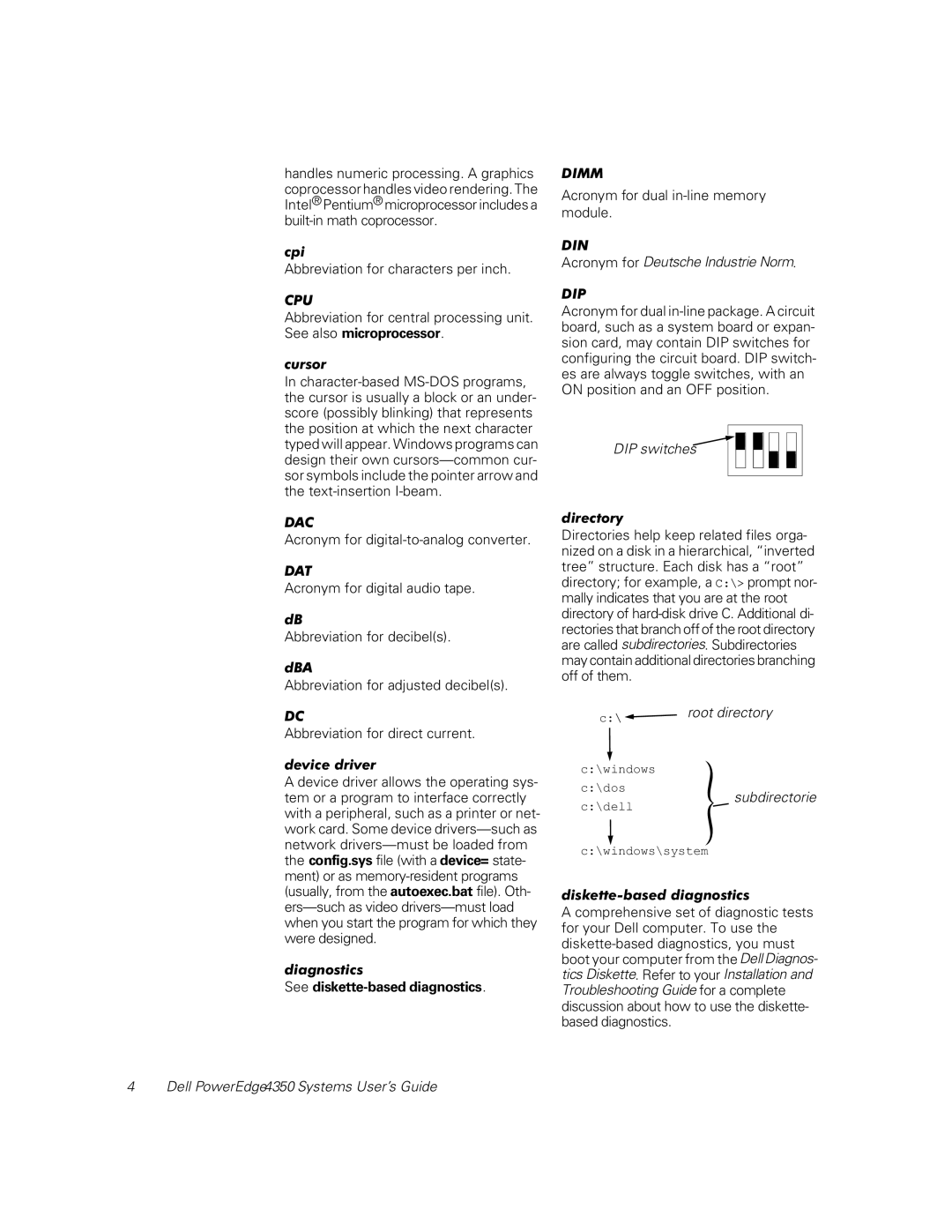865·6*8
Zzzghoofrp
Page
6DIHW\,QVWUXFWLRQV
KHQ8VLQJRXU&RPSXWHU6\VWHP
UJRQRPLF&RPSXWLQJ+DELWV
$51,1*,PSURSHURUSURORQJHGNH\ERDUGXVHPD\UHVXOWLQLQMXU\
KHQRUNLQJLWKRXU&RPSXWHU
Lqvwuxfwlrqvdwwkhiurqwriwklvjxlgh
Viii
3UHIDFH
$ERXW7KLV*XLGH
2WKHURFXPHQWVRX0D\1HHG
DUUDQW\DQG5HWXUQ3ROLF\,QIRUPDWLRQ
1RWHV&DXWLRQVDQGDUQLQJV
1RWDWLRQDO&RQYHQWLRQV
\SRJUDSKLFDO&RQYHQWLRQV
1RERRWGHYLFHDYDLODEOH
Rqwhqwv
Kdswhu
Using Vwduwxsqfi and Dxwrhhfqfi
Page
$SSHQGL
$SSHQGL$
$SSHQGL%
$SSHQGL DUUDQW\5HWXUQ3ROLF\DQGHDU
ESD
ORVVDU\ QGH Ljxuhv
7DEOHV
Qwurgxfwlrq
\VWHPHDWXUHV
Dell PowerEdge4350 Systems User’s Guide
Page
LJXUHURQW3DQHO
URQW3DQHO
6XSSRUWHG2SHUDWLQJ6\VWHPV
LJXUH6WDWXV,QGLFDWRUV
LJXUH+RW3OXJJDEOH+DUGLVNULYH,QGLFDWRUV
3UHYHQWLQJ8QDXWKRULHG$FFHVV,QVLGHWKH 6\VWHP
Rqqhfwlqjwhuqdohylfhv
HWWLQJ+HOS
Dell PowerEdge4350 Systems User’s Guide
Rrwlqjurpwkh
1DYLJDWLQJWKH&0HQXV
8VLQJWKH
8WLOLW\3DUWLWLRQ
7DEOH8WLOLW\3DUWLWLRQ0HQX2SWLRQV
7DEOH8WLOLW\3DUWLWLRQ0HQX2SWLRQVFRQWLQXHG
9LGHRULYHUV
5XQQLQJ6\VWHPLDJQRVWLFV
Page
$VVHW7DJ8WLOLW\
8VLQJWKH$VVHW7DJ8WLOLW\
7DEOH$VVHW7DJ&RPPDQG/LQH2SWLRQV
Dell PowerEdge4350 Systems User’s Guide
Ulyhuv
RU,QWUDQHWDUH
8VLQJ6&6,6HOHFW0HQXV
7KH6&6,6HOHFW8WLOLW\
6WDUWLQJWKH6&6,6HOHFW8WLOLW\
RQILJXUH9LHZ+RVW$GDSWHU6HWWLQJV
LVN8WLOLWLHV
LWLQJ6&6,6HOHFW
6HOHFWHIDXOWV
7DEOH6&6,&RQWUROOHUHIDXOWV
%XV,QWHUIDFHHILQLWLRQV
7DEOH6&6,&RQWUROOHUHIDXOWVFRQWLQXHG
RRWHYLFH2SWLRQV
HYLFH&RQILJXUDWLRQ6HWWLQJV
$GYDQFHG+RVW$GDSWHU6HWWLQJV
Page
QVWDOODWLRQIRU6XSSRUWHGLQGRZV17 6HUYHU2SHUDWLQJ6\VWHPV
QVWDOODWLRQ2YHUYLHZ
QVWDOOLQJ6&6,ULYHUVXULQJLQGRZV17,QVWDOODWLRQ
6HWXSLVLQVSHFWLQJ\RXUFRPSXWHUVKDUGZDUH Frqiljxudwlrq
5HPRYLQJD+RVW$GDSWHU
6ZDSSLQJD+RVW$GDSWHU
7URXEOHVKRRWLQJIRULQGRZV17
3UHVVVSDFHEDU12WRLQYRNHWKH/DVW.QRZQ*RRGPHQX
QVWDOODWLRQ2YHUYLHZ
UHDWLQJWKH,QWUDQHWDUHULYHULVNHWWHV
3UHSDULQJWKH+DUGLVNULYHIRU,QWUDQHWDUH Qvwdoodwlrq
QVWDOOLQJ6&6,ULYHUVXULQJ,QWUDQHWDUH Qvwdoodwlrq
Page
Page
QVWDOOLQJWKHHOO6XSSOLHG1RYHOO3DWFKHVDQG6XSSRUW 3DFN
HOO3URYLGHG,QWUDQHWDUH
QVWDOOLQJ6036XSSRUW
8VLQJVWDUWXSQFIDQGDXWRHHFQFI
8VLQJULYHV7HVWHGDQG$SSURYHGIRU,QWUDQHWDUH
ORDGF?QZVHUYHU?DLFXKDPYHUERVH \VORW
2SWLPLLQJ3HUIRUPDQFH
7URXEOHVKRRWLQJIRU,QWUDQHWDUH
Fgghylfholvw
Phvvdjh
DLOHG3DUVHULYHU3DUDPHWHUVFDOO
8QDEOHWRUHVHUYHKDUGZDUHSRVVLEOHFRQIOLFW
1HWDUHUHMHFWHGFDUGDLOHG$GGLVN6\VWHPFDOO
QYDOLGFRPPDQGOLQHRSWLRQHQWHUHG!RSWLRQ
QYDOLG-YHUERVHVHWWLQJXVH-\
QYDOLG-UHPRYDEOHVHWWLQJXVH-RII
QYDOLG-ILHGBGLVNVHWWLQJXVH-RII
SUHVHQWEXWQRWHQDEOHGFRQILJXUHGIRU3
Dell PowerEdge4350 Systems User’s Guide
8VLQJWKH6\VWHP6HWXS3URJUDP
3UHVV&WUO!$OW!QWHU!IRU6\VWHP6HWXS
QWHULQJWKH6\VWHP6HWXS3URJUDP
\VWHP6HWXS6FUHHQV
8VLQJWKH6\VWHP6HWXS3URJUDP
7DEOH6\VWHP6HWXS1DYLJDWLRQ.H\V
Configuration options Title box Help
LJXUH6\VWHP6HWXS6FUHHQV
LVNHWWHULYH$DQGLVNHWWHULYH%
\VWHP6HWXS2SWLRQV
7LPH
5HVHUYHG0HPRU\
1XP/RFN
3URFHVVRUDQG3URFHVVRU
DQ6SHHG
RRW6HTXHQFH
\VWHP$OHUW
\ERDUGUURUV
3DVVZRUG6WDWXV
6FDQ6HTXHQFH
\VWHP3DVVZRUG
6HWXS3DVVZRUG
0RXVH
6HULDO3RUWDQG6HULDO3RUW
3DUDOOHO3RUW
3DUDOOHO0RGH
Lvnhwwh
6SHDNHU
\VWHPDWD
8VLQJWKH6\VWHP3DVVZRUGHDWXUH
$VVLJQLQJD6\VWHP3DVVZRUG
Page
8VLQJRXU6\VWHP3DVVZRUGWR6HFXUHRXU6\VWHP
\SHLQWKHSDVVZRUGDQG
\SHWKHSDVVZRUGDQGSUHVVQWHU
Qfruuhfwsdvvzrug Qwhusdvvzrug
8VLQJWKH6HWXS3DVVZRUGHDWXUH
HOHWLQJRU&KDQJLQJDQLVWLQJ6\VWHP3DVVZRUG
HOHWLQJRU&KDQJLQJDQLVWLQJ6HWXS3DVVZRUG
$VVLJQLQJD6HWXS3DVVZRUG
2SHUDWLQJLWKD6HWXS3DVVZRUGQDEOHG
LVDEOLQJDRUJRWWHQ3DVVZRUG
5HVSRQGLQJWRUURU0HVVDJHV
8VLQJWKH5HVRXUFH&RQILJXUDWLRQ 8WLOLW\
8VLQJ2QOLQH,QVWUXFWLRQV
6WDUWLQJWKH5&8
0DNLQJ6HOHFWLRQVLQWKH5&8
0DLQ0HQX
HDUQ$ERXW&RQILJXULQJRXU&RPSXWHU
RQILJXUH&RPSXWHU
6WHSVLQFRQILJXULQJ\RXUFRPSXWHU
LJXUH9LHZRUGLWHWDLOV6FUHHQDPSOH
$GYDQFHG0HQX
6HWDWH
6HW7LPH
0DLQWDLQ5HVRXUFH&RQILJXUDWLRQLVNHWWH
RFN8QORFN%RDUGV
9LHZ$GGLWLRQDO6\VWHP,QIRUPDWLRQ0HQX
6HW9HULILFDWLRQ0RGH0HQX
$GYDQFHGPHQX Rfnxqorfnerdugv
5HVROYLQJ5HVRXUFH&RQIOLFWV
0DLQWDLQ6&,LOHV0HQX
Dxwlrq
Zlwklqrughuwrvdyhdfruuhfwfrqiljxudwlrq
Qvwdoohg
5HPRYLQJD&DUGWKDW&RQIOLFWVLWKWKH&DUGRX-XVW
Dell PowerEdge 4350 Systems User’s Guide
7HFKQLFDO6SHFLILFDWLRQV
7DEOH$7HFKQLFDO6SHFLILFDWLRQV
7DEOH$7HFKQLFDO6SHFLILFDWLRQVFRQWLQXHG
3RZHU
Dell PowerEdge4350 Systems User’s Guide
23RUWVDQG&RQQHFWRUV
6HULDODQG3DUDOOHO3RUWV
LJXUH%,23RUWVDQG&RQQHFWRUV
6HULDO3RUW&RQQHFWRUV
LJXUH%3LQ1XPEHUVIRUWKH6HULDO3RUW&RQQHFWRUV
3DUDOOHO3RUW&RQQHFWRU
LJXUH%3LQ1XPEHUVIRUWKH3DUDOOHO3RUW&RQQHFWRU
\ERDUGDQG0RXVH&RQQHFWRUV
0RXVH&RQQHFWRU
LJXUH%3LQ1XPEHUVIRUWKH0RXVH&RQQHFWRU
Kbdata
Kbclk
9LGHR&RQQHFWRU
7DEOH%3LQ$VVLJQPHQWVIRUWKH0RXVH&RQQHFWRU
LJXUH%3LQ1XPEHUVIRUWKH9LGHR&RQQHFWRU
Mfdata
7DEOH%3LQ$VVLJQPHQWVIRUWKH9LGHR&RQQHFWRU
6HUYHU0DQDJHPHQW%XV&RQQHFWRUV
LJXUH%3LQ1XPEHUVIRUWKH6HUYHU0DQDJHPHQW%XV Rqqhfwruv
Dell PowerEdge4350 Systems User’s Guide
Dfnxshylfhv
DWD3UHVHUYDWLRQ
6FKHGXOLQJ%DFNXSV
OHDQLQJ6\VWHP&RPSRQHQWV
5HFRYHULQJDWD
5HFRPPHQGHG7RROVDQG$FFHVVRULHV
OHDQLQJWKH6\VWHP0RQLWRUDQG.H\ERDUGWHULRUV
Page
XVWDQG3DUWLFOHV
+XPLGLW\
$OWLWXGH
Ruurvlrq
OHFWURPDJQHWLFDQG5DGLRUHTXHQF\,QWHUIHUHQFH
0DJQHWLVP
6KRFNDQG9LEUDWLRQ
3RZHU6RXUFH,QWHUUXSWLRQV
3RZHU3URWHFWLRQHYLFHV
6XUJH3URWHFWRUV
LQH&RQGLWLRQHUV
8QLQWHUUXSWLEOH3RZHU6XSSOLHV
Dell PowerEdge4350 Systems User’s Guide
5HJXODWRU\1RWLFHV
1RWLFHV862QO\
HOO3RZHUGJH6\VWHPV8VHUV*XLGH
1RWLFH&DQDGD2QO\
ODVV$
1RWLFHXURSHDQ8QLRQ
Wdnhdghtxdwhphdvxuhv
ODVV%,7
ODVV%HYLFH
02&1RWLFH6RXWK.RUHD2QO\
ODVV$HYLFH
1PPTUBFJOTUSVLDKFCFQJFDFËTUXB
1RWLFH
8ZNBHBOJB1PMTLJFHP$FOUSVN#BEBËJ $FSUZGJLBDKJ
Fmfnfouíxxfxoäusozdi
120,QIRUPDWLRQ0HLFR2QO\
Obefquzxbàmvcqpuzlbàtjäpojf
41RWLFH7DLZDQ2QO\
10 HOO3RZHUGJH6\VWHPV8VHUV*XLGH
RYHUDJHXULQJHDU2QH
DUUDQW\5HWXUQ3ROLF\DQGHDU
LPLWHG7KUHHHDUDUUDQW\86DQG &DQDGD2QO\
RYHUDJHXULQJHDUV7ZRDQG7KUHH
HQHUDO3URYLVLRQV
´7RWDO6DWLVIDFWLRQµ5HWXUQ3ROLF\86DQG &DQDGD2QO\
HDU6WDWHPHQWRI&RPSOLDQFHIRU HOO%UDQGHG+DUGZDUH3URGXFWV
3UHYLRXV3URGXFWV
6RIWZDUH
$GGLWLRQDO,QIRUPDWLRQ
Dell PowerEdge4350 Systems User’s Guide
Dgdswhufdug
Dssolfdwlrq
Dxwrhhfedwiloh
Edfnxs
EDVHPHPRU\
Basic Edwfkiloh
Edxgudwh
Ehhsfrgh
\WH
Fdfkh
Fdughgjhfrqqhfwru
FRQILJV\VILOH
FSL
Fxuvru
Ghylfhgulyhu
GLUHFWRU\
GULYHW\SHQXPEHU
GLVSOD\DGDSWHU
GSL
HSDQGHGPHPRU\
Hsdqvlrqexv
Hsdqvlrqfdugfrqqhfwru
HWHQGHGPHPRU\
Judsklfvfrsurfhvvru
Judsklfvprgh
Jxduglqj
Khdwvlqn
Lqwhuodflqj
NH\FRPELQDWLRQ
Orfdoexv
Pdwkfrsurfhvvru
PHPRU\
PHPRU\DGGUHVV
Prxvh
PXOWLIUHTXHQF\PRQLWRU
1L&DG
Qrqlqwhuodfhg
Shulskhudoghylfh
Slho
SSP
Surjudpglvnhwwhvhw
Dell PowerEdge4350 Systems User’s Guide
UHDGRQO\ILOH
Uhdoprgh
Uhiuhvkudwh
USP
Vwulslqj
Vzlwfk
\QFQHJRWLDWLRQ
\QWD
Whwhglwru
Whwprgh
WSL
XSSHUPHPRU\DUHD
$IHDWXUHFRQQHFWRU
Ylghrdgdswhu
Ylghrgulyhu
YLGHRPHPRU\
YLUWXDOPHPRU\
Yluxv
9SS
Zlqlqliloh
Dell PowerEdge4350 Systems User’s Guide
QGH
Page
Page
PCI
Scsi

